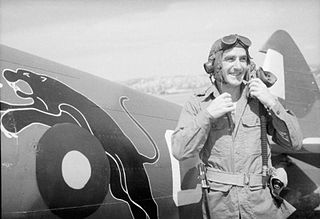
No. 152 (Hyderabad) Squadron RAF was an aircraft squadron of the Royal Air Force during both World War I and World War II.
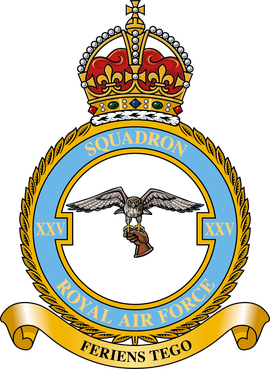
Number 25 (Fighter) Squadron is a squadron of the Royal Air Force having reformed on 8 September 2018.

Number 47 Squadron is an inactive squadron of the Royal Air Force. Previously based at RAF Brize Norton, Oxfordshire, it last operated the Lockheed Martin Hercules C4/C5 between 2013 and 2023. It previously flew the Lockheed Hercules C.1/C.3 between 1968 and 2013.
No. 213 Squadron was a squadron of the Royal Air Force. The squadron was formed on 1 April 1918 from No. 13 (Naval) Squadron of the Royal Naval Air Service. This RNAS squadron was itself formed on 15 January 1918 from the Seaplane Defence Flight which, since its creation in June 1917, had had the task of defending the seaplanes which flew out of Dunkirk.

No. 489 (NZ) Squadron was a torpedo bomber squadron established for service during the Second World War. It was a New Zealand squadron formed under Article XV of the Empire Air Training Plan. Although its flying personnel were largely drawn from the Royal New Zealand Air Force, the squadron served in Europe under the operational and administrative command of the Royal Air Force as part of Coastal Command.

No. 211 Squadron RAF was a squadron in the Royal Air Force active from 1917 to 1919 and from 1937 to 1946. In World War I it operated as a bomber and later a reconnaissance unit on the Western Front. In World War II it operated as a medium bomber unit in the Middle East and Far East and later as a strike fighter unit in the Far East, equipped with, successively, the Bristol Blenheim, the Bristol Beaufighter and de Havilland Mosquito.
Royal Air Force Montrose or more simply RAF Montrose is a former Royal Air Force station in Forfarshire in Scotland. It became the first operational military aerodrome to be established in the United Kingdom on 26 February 1913.
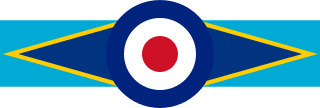
The name No. 68 Squadron has been used for two quite different units, only one of which was strictly a unit of the Royal Air Force. "No. 68 Squadron RFC" was for a time the official British military designation for No. 2 Squadron Australian Flying Corps.
No. 189 Squadron was a Royal Air Force squadron.
No. 203 Squadron RAF was originally formed as No. 3 Squadron Royal Naval Air Service. It was renumbered No. 203 when the Royal Air Force was formed on 1 April 1918.

No. 141 Squadron was a squadron of the British Royal Air Force. It was first formed as part of the Royal Flying Corps in January 1918 as a fighter squadron, serving on home defence duties for the rest of the First World War., before being disbanded in 1920. The Second World War resulted in the squadron being reformed in 1939, serving as a night fighter and night intruder squadron until being disbanded in September 1945. it was reformed again in 1946, flying night fighters until 1958, while from 1959 until 1964 operated surface-to-air missiles.
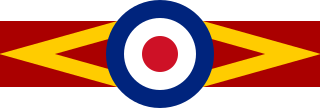
Number 80 Squadron is a squadron of the Royal Air Force. It was reformed on 15 April 2024 at Eglin Air Force Base, Florida, after the numberplate was awarded to the British team at the Australia, Canada and United Kingdom Reprogramming Laboratory (ACURL). It was a Royal Flying Corps (RFC) and Royal Air Force (RAF) squadron active from 1917 until 1969. It was operative during both the First and Second World Wars.
Air Commodore Roy Kenneth Orrock DFC was a British pilot during the Second World War and a senior Royal Air Force officer in the post-war years. He served as the fourteenth Commandant Royal Observer Corps from 1973 to 1975. He was Aide-de-camp to Queen Elizabeth II.

No. 217 Squadron RAF was a squadron of the RAF. It was formed and disbanded four times between 1 April 1918 and 13 November 1959. In World War I it served in a strike role against enemy bases and airfields in Belgium. In World War II as part of RAF Coastal Command it served first in a maritime patrol role along the Western Approaches and later in an anti-shipping role in the English Channel. Ordered to the Far East in 1942, the squadron was retained for two months in Malta in an anti-shipping role, protecting Allied convoys, before moving to Ceylon to defend the approaches to India, serving in an anti-submarine and anti-shipping role. It was equipped and training for a strike role, when the war ended. In the postwar period, it served for five years in a maritime reconnaissance role, and then briefly in a support role for Operation Grapple, the British hydrogen bomb tests on Christmas Island.
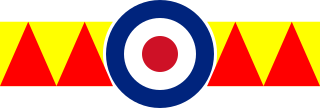
No. 604 Squadron RAF was a squadron of the Royal Air Force noted for its pioneering role the development of radar-controlled night-fighter operations. The squadron was established in March 1930 at RAF Hendon as a day-bomber squadron of the Royal Auxiliary Air Force. In July 1934, the squadron transitioned to two-seat fighters. Shortly after the commencement of World War II in 1939, the squadron was reassigned to a night-fighter role.

No. 219 Squadron of the Royal Air Force was founded in 1918 and disbanded in 1957 after four separate periods of service. During the First World War it served as a coastal defence unit, and through most of the Second World War and the 1950s it operated as a night fighter air defence squadron. Three commanders of the squadron went on to be Chiefs of the Air Staff, two of the RAF and one of the Royal Pakistani Air Force.
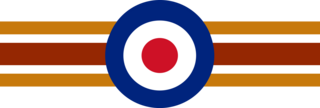
Number 125 (Newfoundland) Squadron was a Royal Air Force squadron active during World War II and briefly in the mid-1950s. Throughout its service the squadron primarily operated night fighters.
Air Vice Marshal Edward Dixon Crew, was a Royal Air Force officer and a nightfighter ace of the Second World War. He shot down 15 enemy aircraft and was one of the top-scoring aces against the V-1 flying bomb.

Raymond "Chaz" Bowyer was a Royal Air Force armaments and explosives instructor who, after he retired from service, wrote and edited over forty books relating to the operations, aircraft, and men of the Royal Flying Corps, Royal Air Force, and Royal Naval Air Service. He also edited for publication the memoirs of the pilots C.P.O. Bartlett, Eric Crundall, and Gwilym H. Lewis.






















